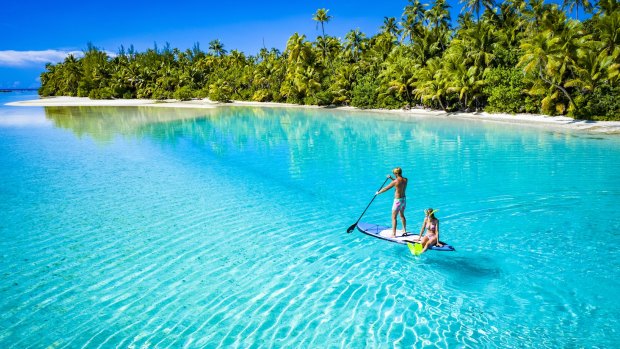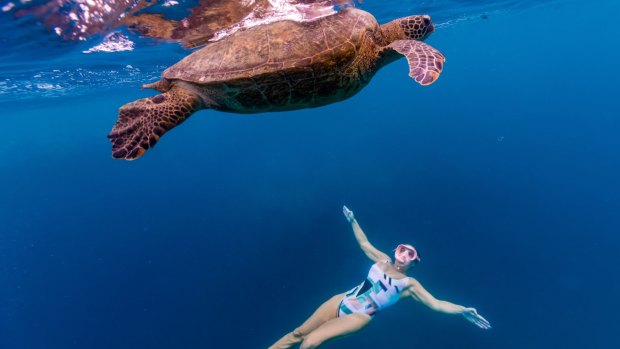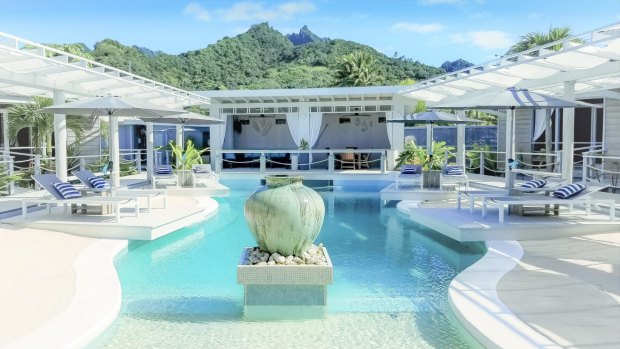This was published 2 years ago
Cook Islands reopens: New things to see and do in the Pacific paradise
By Craig Tansley

Aitutaki is famous for its equilateral-shaped triangular lagoon five times larger than the island surrounding it.Credit: Cook Islands Tourism
"Life was really busy before COVID," Maunga Tours owner/guide Bruce Goldsworthy tells me as we tip-toe along slippery boulders above a creek. "Then the island went into a hibernated state. We got to sit back and smell the roses. Well, frangipani. Rarotonga doesn't have a lot of roses."
Goldsworthy and I have set out to climb Rarotonga's tallest mountain, Te Manga, on a Sunday morning when a fair percentage of the population are either in bed, or in church. I could've done his easier tour tomorrow – a cross-island walk with gentler-sloping, better-cut trails – but Goldsworthy assures me this summit is worth the scrapes and bruises.
"No-one's been on this track for two years," he tells me. "I had to come up yesterday with a machete to chop out a path for you."

Discover Rarotonga's turtles on a new tour with local Charlotte Piho.Credit: Charlotte Piho
It's an ordeal: I'm climbing up ropes put in 35 years ago by a botanist hell bent on studying the plants that grow here and nowhere else on Earth. We're among the largest tract of cloud forest anywhere in the tropical Pacific. At the summit I stand on a narrow ridgeline above a vast, uninhabited green valley with Rarotonga spread out in all directions below my feet. You won't get a better vantage point anywhere in the Cook Islands. Yet, I'm the first traveller here in two years.
There are a lot of new things to discover now the Cook Islands are open to Australian travellers again. In March, 2020, the country's international borders were closed in a bid to stop COVID-19. In May, 2021, the New Zealand Government created a quarantine-free travel bubble with New Zealand tourists and Australian travellers weren't included. It wasn't until April 13 this year that Australians were allowed back in. Traditionally outnumbered three-to-one by New Zealand travellers, lately it's more like 20-to-one.
When I return to ground level, I ride my scooter along the Pacific's oldest road, Ara Tapu, to the southern side of Rarotonga. Local Charlotte Piho is waiting. She started swimming tours with turtles just before Rarotonga went into enforced COVID-19 isolation. Now she's booked solid.

Rarotonga's newest, eco-friendly accommodation, Ocean Escape Resort and Spa.
"Since people could get back into Rarotonga, no-one wants to stay in their hotels," she says. "People just seem grateful to be out and about. I'm getting lots of families who want to get out and share something unique together."
We swim across the lagoon to a gap in the reef at a passage called Ava'avaroa. Below the water, a community of green and hawksbill turtles are waiting.
"They're there every day in the same spots," Piho says. "We've got names for all of them. We give them lots of space, but they never swim away. The Cook Islands feel like I'm in Moana. I've travelled all over the world but I don't know any other country where you can connect with creatures in the sea like here. I've seen 20 eagle rays swimming together, I've swum with humpback whales a few metres out from the reef. It's all just … here."
Meanwhile, on the western side of the island, tourism veteran Temu Okotai developed a tour during lockdown which shows an aspect of Cook Islanders' lives not displayed before to outsiders.
"Being shut down made me look around to examine what it is that makes us unique," he says.
"I think people who haven't been able to visit like to see how we lived, and what we went back to while we were isolated from the world."
The Reef Man Tour lets guests spend an afternoon on the reef, in the lagoon and on the beach with a local while they fish and fossick for dinner. Though it's strictly catch-and-release, I learn how to harvest food from the reef and how to catch fish in the lagoon. We end the tour with an umu (earth oven) we helped build earlier, eating fish, chicken, pork and vegetables wrapped in banana leaves, cooked for hours on coals.
At night, I sleep in a new resort that's now the Cook Islands' most eco-friendly accommodation option. Running off solar power, with drinking water collected from its roof and with a swimming pool that pumps sea water from a lagoon 30 metres away, Ocean Escape Resort & Spa caters for a discerning type of traveller.
The dream of an Australian couple, Barry and Jade Weizman, who eloped to Rarotonga, fell in love with the island and came back to live here. Barry says guests tell him the eco-friendly offerings are the reason they choose to stay.
Completed in January 2021, the Weizmans' first guests were locked up during the resort's stint as a quarantine hotel. I lie in a hammock strung out between coconut trees, listening to the crash of waves on the reef, contemplating prison life here.
"They all had COVID," Barry says. "So they didn't have to social distance, they had bonfires on the beach at night, they swam all day in the pool. This might've been the nicest COVID quarantine hotel on Earth."
Cook Islands Tourism Corporation's Karla Eggelton says people want different kinds of attractions after two years of lockdown.
"I think people want to feel more connected now than they ever did," she says. "We need to offer varying experiences, people are demanding connectivity, and sustainability."
One Cook Island where Australian visitors outnumber New Zealanders is Aitutaki, 40 minutes flying time north of Rarotonga. Famous for an equilateral-shaped triangular lagoon five times larger than the island surrounding it, I land here on a cloudless winter's day.
I'm booked on a three-hour tour of the lagoon by hobie cat with only the wind to get me round it. There are 15 tiny islets in the lagoon – just one is inhabited. Captain Ted Tavai has the rudder, but 10 minutes out from shore, he hands it over, and I use a gentle south-easterly breeze to guide me to the lagoon's outer reaches.
Tavai gave up a job at a Cook Islands' top-rated resort to run sailing tours. Times were tough during the Cook Islands' enforced isolation, but since the islands reopened, Tavai says his bookings have been stable. "What's more eco-friendly than this?" he asks.
"I've found people have been craving that, and getting away from other tourists since they started coming back. No-one seems to like being around other people."
Next morning, I take a half-day charter with local boat operator Quinton Schofield. For $NZ350 he takes me anywhere I want to go across the 70-square-kilometre lagoon, and throws me out the back of his boat on a rope to wakeboard.
When we're done, he invites me round to his place for sunset beers: I can't imagine getting that anywhere else with such a charter fee.
Dinner's a local sort of affair, in a newly-built open-air restaurant in the centre of the island, opened by a local who returned from Australia with his wife before COVID-19.
They opened on March 12, 2020; a week later, the Cook Islands shut its international borders.
"We were devastated," co-owner Karin Wilson says. "But now we're just trying to keep up with the influx of people coming back. Though I haven't seen too many Australians yet."
Her restaurant, Avatea Cafe, epitomises Aitutaki's South Seas charm. Locals and travellers sit at tables under a corrugated iron roof with chickens and their chicks wandering in between. Outside the sky turns crimson and locals drive by on mopeds, calling out greetings.
Thirty minutes earlier, I sat in a treehouse restaurant watching whales breach just beyond the lagoon at the Cook Islands' most luxurious accommodation, Pacific Resort Aitutaki . That's long been the appeal of the Cook Islands: luxury and connectivity with the local people are never two separate entities.
Aitutaki and Rarotonga are only the beginning of a Cook Islands adventure - there are another 13 Cook Islands you can visit.
All but five Cook Islands have traditionally been quite expensive to visit and some had once-a-month flight schedules. But since the Cook Islands' enforced isolation ended, tourism operators are conceiving ways to get visitors out to the Cook Islands' remote Northern Group on tours by plane with home-stay accommodation.
"We're making sure this is a non-intrusive way to see our most remote communities," Eggelton says. "These will be some of the most remote places people can visit in the Pacific."
THE DETAILS
MORE
FLY
Fly from Melbourne, Sydney or Brisbane via Auckland with Air New Zealand, airnz.com.au or Jetstar, jetstar.com.au
Sydney to Rarotonga non-stop flights are expected to resume later this year.
STAY
Pacific Resort Aitutaki is one of the Pacific's most awarded resorts, pacificaitutaki.com
Or stay in Rarotonga's newest eco-friendly resort, www.oceanescaperesort.com
DO
Hike Rarotonga's mountains, maungatours.com, discover how locals use the reef to live, cookislandstours.co.ck swim with turtles, charlottepiho.com sail Aitutaki's lagoon, sailaitutaki.com take a private boat charter of the lagoon, wetnwild-aitutaki.com
The writer travelled courtesy of Cook Islands Tourism
Sign up for the Traveller Deals newsletter
Get exclusive travel deals delivered straight to your inbox. Sign up now.